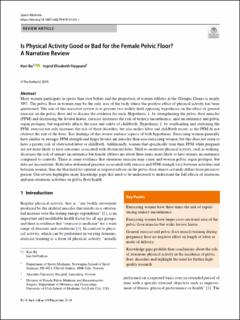| dc.contributor.author | Bø, Kari | |
| dc.contributor.author | Nygaard, Ingrid Elisabeth | |
| dc.date.accessioned | 2020-05-08T09:49:31Z | |
| dc.date.available | 2020-05-08T09:49:31Z | |
| dc.date.created | 2019-12-11T11:33:52Z | |
| dc.date.issued | 2019 | |
| dc.identifier.citation | Sports Medicine. 2020, 50(3), 471–484. | en_US |
| dc.identifier.issn | 0112-1642 | |
| dc.identifier.uri | https://hdl.handle.net/11250/2653711 | |
| dc.description | This article is licensed under a Creative Commons Attribution 4.0 International License, which permits use, sharing, adaptation, distribution and reproduction in any medium or format, as long as you give appropriate credit to the original author(s) and the source, provide a link to the Creative Commons licence, and indicate if changes were made. The images or other third party material in this article are included in the article’s Creative Commons licence, unless indicated otherwise in a credit line to the material. If material is not included in the article’s Creative Commons licence and your intended use is not permitted by statutory regulation or exceeds the permitted use, you will need to obtain permission directly from the copyright holder. To view a copy of this licence, visit http://creativecommons.org/licenses/by/4.0/. | en_US |
| dc.description.abstract | More women participate in sports than ever before and the proportion of women athletes at the Olympic Games is nearly 50%. The pelvic floor in women may be the only area of the body where the positive effect of physical activity has been questioned. The aim of this narrative review is to present two widely held opposing hypotheses on the effect of general exercise on the pelvic floor and to discuss the evidence for each. Hypothesis 1: by strengthening the pelvic floor muscles (PFM) and decreasing the levator hiatus, exercise decreases the risk of urinary incontinence, anal incontinence and pelvic organ prolapse, but negatively affects the ease and safety of childbirth. Hypothesis 2: by overloading and stretching the PFM, exercise not only increases the risk of these disorders, but also makes labor and childbirth easier, as the PFM do not obstruct the exit of the fetus. Key findings of this review endorse aspects of both hypotheses. Exercising women generally have similar or stronger PFM strength and larger levator ani muscles than non-exercising women, but this does not seem to have a greater risk of obstructed labor or childbirth. Additionally, women that specifically train their PFM while pregnant are not more likely to have outcomes associated with obstructed labor. Mild-to-moderate physical activity, such as walking, decreases the risk of urinary incontinence but female athletes are about three times more likely to have urinary incontinence compared to controls. There is some evidence that strenuous exercise may cause and worsen pelvic organ prolapse, but data are inconsistent. Both intra-abdominal pressure associated with exercise and PFM strength vary between activities and between women; thus the threshold for optimal or negative effects on the pelvic floor almost certainly differs from person to person. Our review highlights many knowledge gaps that need to be understood to understand the full effects of strenuous and non-strenuous activities on pelvic floor health. | en_US |
| dc.language.iso | eng | en_US |
| dc.subject | urinary incontinence | en_US |
| dc.subject | intraabdominal pressure | en_US |
| dc.subject | vaginal pressure | en_US |
| dc.subject | transabdominal utlrasound | en_US |
| dc.subject | activity restrictions | en_US |
| dc.subject | muscle activity | en_US |
| dc.subject | exercise | en_US |
| dc.subject | women | en_US |
| dc.subject | prevalence | en_US |
| dc.subject | impact | en_US |
| dc.title | Is Physical Activity Good or Bad for the Female Pelvic Floor? A Narrative Review | en_US |
| dc.type | Peer reviewed | en_US |
| dc.type | Journal article | en_US |
| dc.description.version | publishedVersion | en_US |
| dc.source.pagenumber | 471–484 | en_US |
| dc.source.journal | Sports Medicine | en_US |
| dc.identifier.doi | 10.1007/s40279-019-01243-1 | |
| dc.identifier.cristin | 1759226 | |
| dc.description.localcode | Seksjon for idrettsmedisinske fag / Department of Sports Medicine | en_US |
| cristin.unitcode | 150,34,0,0 | |
| cristin.unitname | Seksjon for idrettsmedisinske fag | |
| cristin.ispublished | true | |
| cristin.fulltext | original | |
| cristin.qualitycode | 1 | |
